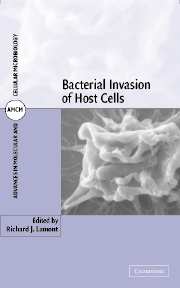Book contents
- Frontmatter
- Contents
- Contributors
- Preface
- Bacterial Invasion of Host Cells
- 1 Invasion mechanisms of Salmonella
- 2 Shigella invasion
- 3 How Yersinia escapes the host: To Yop or not to Yop
- 4 Stealth warfare: The interactions of EPEC and EHEC with host cells
- 5 Molecular ecology and cell biology of Legionella pneumophila
- 6 Listeria monocytogenes invasion and intracellular growth
- 7 N. gonorrhoeae: The varying mechanism of pathogenesis in males and females
- 8 Group A streptococcal invasion of host cells
- 9 Invasion of oral epithelial cells by Actinobacillus actinomycetemcomitans
- 10 Invasion by Porphyromonas gingivalis
- Index
- Plate section
- References
6 - Listeria monocytogenes invasion and intracellular growth
Published online by Cambridge University Press: 21 August 2009
- Frontmatter
- Contents
- Contributors
- Preface
- Bacterial Invasion of Host Cells
- 1 Invasion mechanisms of Salmonella
- 2 Shigella invasion
- 3 How Yersinia escapes the host: To Yop or not to Yop
- 4 Stealth warfare: The interactions of EPEC and EHEC with host cells
- 5 Molecular ecology and cell biology of Legionella pneumophila
- 6 Listeria monocytogenes invasion and intracellular growth
- 7 N. gonorrhoeae: The varying mechanism of pathogenesis in males and females
- 8 Group A streptococcal invasion of host cells
- 9 Invasion of oral epithelial cells by Actinobacillus actinomycetemcomitans
- 10 Invasion by Porphyromonas gingivalis
- Index
- Plate section
- References
Summary
Studies focused on the Gram-positive, facultative intracellular bacterial path-ogen Listeria monocytogenes have provided valuable insights into many facets of biology, including cell-mediated immunity, cell physiology, and bacterial pathogenesis. The bacterium invades and replicates within a wide variety of cell types, and is capable of infecting an astonishing diversity of hosts, including mammals, fish, and insects (Gray and Killinger, 1966). The well-established use of murine and tissue culture models of infection, the ease of growing L. monocytogenes within the laboratory, and the existence of numerous genetic tools for the generation and analysis of bacterial mutants have helped to make L. monocytogenes a powerful model system for the exploration of the molecular basis of host–pathogen interactions. Because of its ubiquity within the environment and robust survival skills, this important foodborne pathogen remains a constant concern for public health departments and the food industry.
Listeriae are noncapsulated, nonspore-forming, facultative anaerobic bacilli. They are 0.4 μm by 1 to 1.5 μm in size and are motile at 10°C to 25°C through the expression of polar flagellae (Farber and Peterkin, 1991; Lorber, 1997; Vazquez-Boland et al., 2001b). There are six species in the Listeria genus: L. monocytogenes, L. ivanovii, L. innocua, L. seeligeri, L. welshimeri, and L. grayi (Collins et al., 1991; Sheehan et al., 1994). Only L. monocytogenes and L. ivanovii are considered pathogenic and are responsible for the disease known as listeriosis.
- Type
- Chapter
- Information
- Bacterial Invasion of Host Cells , pp. 161 - 202Publisher: Cambridge University PressPrint publication year: 2004
References
- 2
- Cited by



